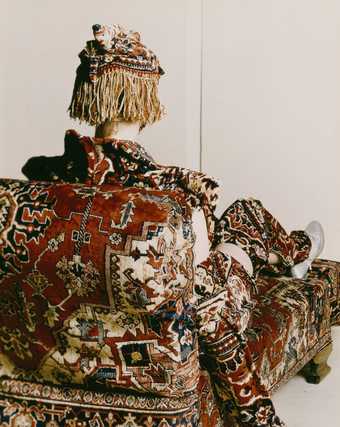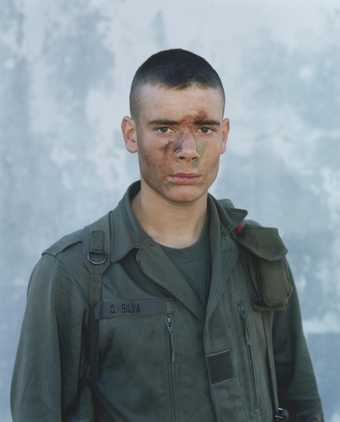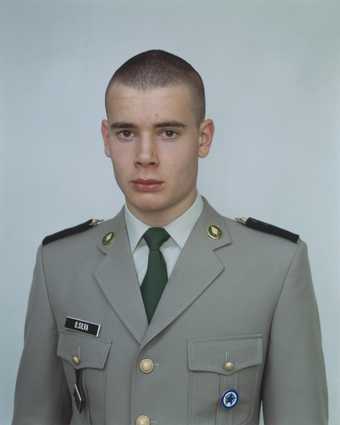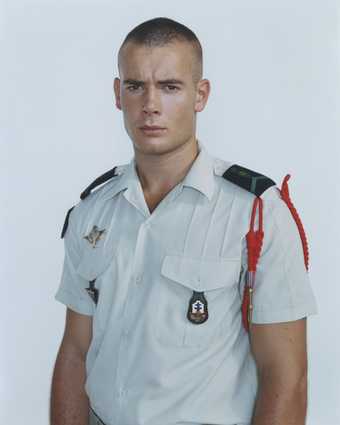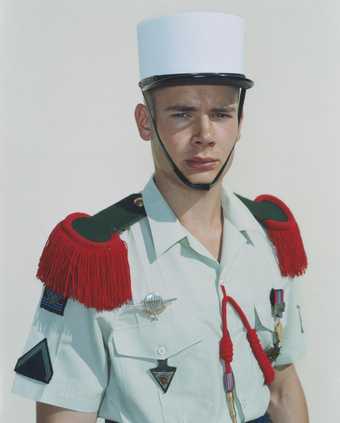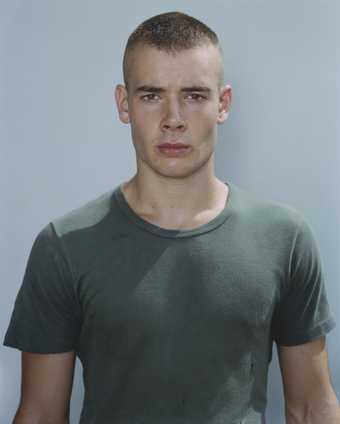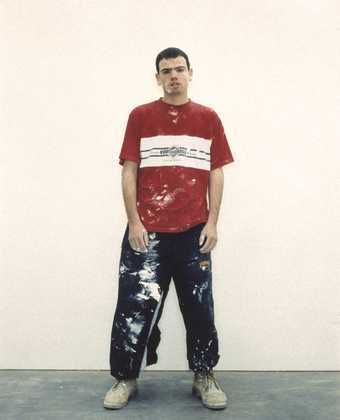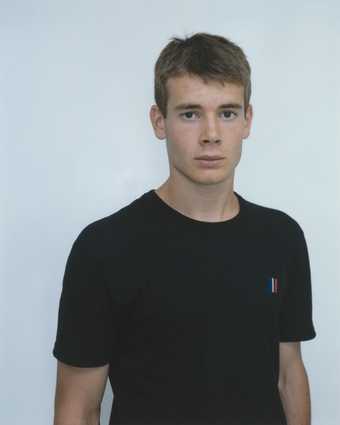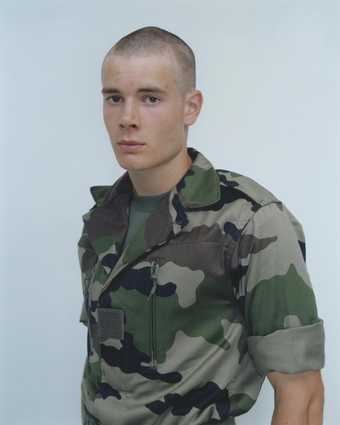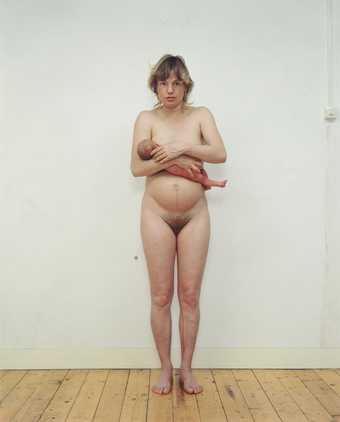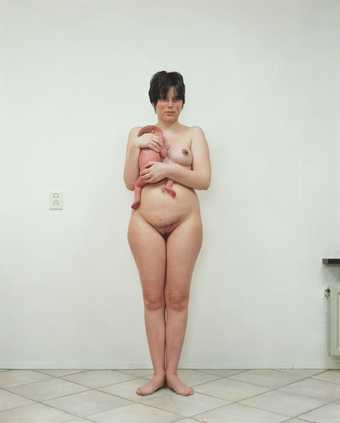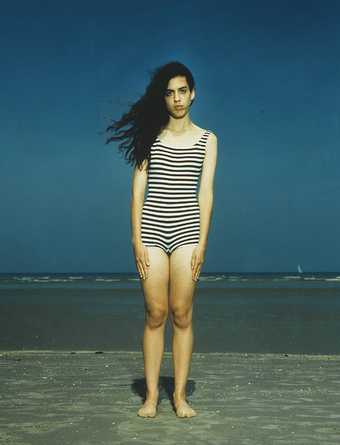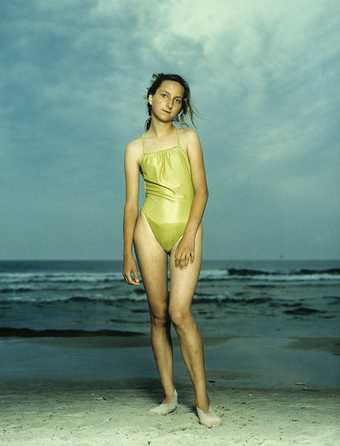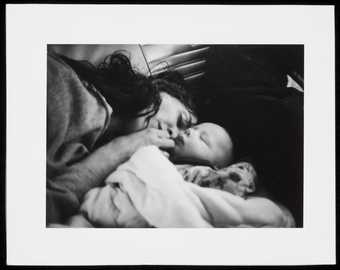
Not on display
- Artist
- Rineke Dijkstra born 1959
- Medium
- Photograph, inkjet print on paper, mounted on aluminium
- Dimensions
- Image: 1170 × 940 mm
- Collection
- Tate
- Acquisition
- Purchased 1998
- Reference
- P78097
Summary
Julie, Den Haag, Netherlands, February 29 1994, Tecla, Amsterdam, Netherlands, May 16 1994 (Tate P78098) and Saskia, Harderwijk, Netherlands, March 16 1994 (Tate P78099) are three portraits of women made shortly after they had given birth. All the women were known to the artist – one was a personal friend and the other two were friends of friends. Dijkstra photographed the women in their homes because in Holland it is more common for women to give birth at home than in a hospital. While bearing signs of their recent ordeal – the medical pants and sanitary towel which Julie wears, a trickle of blood down the inside of Tecla’s left leg, the caesarean scar on Saskia’s belly – the women appear proud and happy. They hold their new babies turned away from the camera, protectively pressed against their bodies. Dijkstra has developed a way of combining natural light with flash which results in particular quality of soft, clear light. Julie’s left hand covers her baby’s eyes to protect them from the flash.
Dijkstra was inspired to make these portraits after watching the birth of a friend’s baby. She is interested in photographing people at a time when they do not have everything under control. She uses the device of the formally posed, full-length portrait to try to reveal something of what people carry inside them – the emotional intensity concealed behind the mask of the face and the body’s pose. The photographic portrait, titled with the date and place, records a specific moment in time in which the subject was undergoing a particular experience. Dijkstra has commented:
As a photographer you enlarge or emphasize a certain moment, making it another reality. For instance the portraits I made of women after giving birth: the reality of this experience is about the whole atmosphere, which is very emotional. In the photograph, you can scrutinize all the details, which makes it a bit harsh: you can see things you normally would not pay so much attention to.
(Quoted in Douglas, p.79.)
In the same year that Dijkstra photographed the new mothers, she photographed matadors in Portugal, just after they had come out of the ring. Like the new mothers, the bull-fighters had been in emotionally charged, potentially life-threatening situations. Both mothers and matadors are captured in a state of physical and emotional catharsis which contributes to the intensity of their engagement with the camera. Dijikstra uses 4 x 5 inch film to make her portraits, demanding time and concentration on the part of both artist and subject. She is sensitive to the vulnerability which her subjects give her access to and is careful not to abuse their trust. She has explained of the new mothers:
It’s amazing how they trust me, and I think that afterwards they understand that these photos are about something universal and that it’s not particularly about them ...the first show I had in Amsterdam with these photos a lot of women came to me and said, you know it’s really great that you make these photographs because it’s really the way it is but nobody ever shows it, and I can recognize myself in it. And the men were all like, you can’t show a woman like that.’
(Quoted in unpublished interview with Tate Modern Curator Jane Burton, on the occasion of the exhibition Cruel and Tender, in 2003.)
Julie, Den Haag, Netherlands, February 29 1994 is a framed colour photograph. It was produced in an edition of six in a large scale and fifteen in a smaller size. Tate’s copy is the fifth out of the six large scale prints.
Further reading:
Sarah Douglas, ‘Rineke Dijkstra: the gap between intention and effect’, Flash Art, October 2003, pp.78-80
Rineke Dijkstra: Portraits, exhibition catalogue, Institute of Contemporary Art, Boston 2001, pp.79 and 87-91, reproduced p.87 in colour
Rineke Dijkstra, exhibition catalogue, Photographer’s Gallery, London 1997, [p.33], reproduced [p.24] in colour
Elizabeth Manchester
July 2005
Does this text contain inaccurate information or language that you feel we should improve or change? We would like to hear from you.
Display caption
Dijkstra decided to make these portraits after witnessing the birth of a friend’s baby. She photographed three women, one hour (Julie), one day (Tecla) and one week (Saskia) after giving birth. The raw immediacy of these images captures something of the contradictions inherent in this common and yet most singular of human experiences. The women appear at once vulnerable and invincible, traumatised and self-composed.
Gallery label, May 2010
Does this text contain inaccurate information or language that you feel we should improve or change? We would like to hear from you.
Explore
- emotions, concepts and ideas(16,416)
-
- emotions and human qualities(5,345)
-
- vulnerability(311)
- formal qualities(12,454)
-
- photographic(4,673)
- public and municipal(956)
-
- hospital(99)
- clothing and personal items(5,879)
-
- underwear(73)
- actions: expressive(2,622)
-
- protecting(55)
- woman(9,110)
- baby(526)
- Julie(1)
- female(1,681)
- individuals: female(1,698)
- birth to death(1,472)
-
- birth(77)
- mother and child(394)
You might like
-
Liza May Post Attempt
1996 -
Rineke Dijkstra Olivier, Les Guerdes, France, November 1, 2000
2000–3, printed 2014 -
Rineke Dijkstra Olivier, Quartier Viénot, Marseille, November 30, 2000
2000–3, printed 2014 -
Rineke Dijkstra Olivier, Quartier Monclar, Djibouti, July 13, 2003
2000–3, printed 2014 -
Rineke Dijkstra Olivier, Camp Raffalli, Calvi, Corsica, June 18 2001
2000–3, printed 2014 -
Rineke Dijkstra Olivier, Camp Général de Gaulle, Libreville, Gabon, June 2, 2002
2000–3, printed 2014 -
Rineke Dijkstra James. Tate Modern, London. 10 December 1999
1999 -
Rineke Dijkstra Olivier, Quartier Viénot, Marseille, July 21, 2000 (A)
2000–3, printed 2014 -
Rineke Dijkstra Olivier, Quartier Viénot, Marseille, July 21, 2000 (B)
2000–3, printed 2014 -
Rineke Dijkstra Tecla, Amsterdam, Netherlands, May 16 1994
1994, printed 2021 -
Rineke Dijkstra Saskia, Harderwijk, Netherlands, March 16 1994
1994, printed 2021 -
Rineke Dijkstra De Panne, Belgium, August 7 1992
1992 -
Rineke Dijkstra Kolobrzeg, Poland, July 23 1992
1992 -
Rineke Dijkstra Kolobrzeg, Poland, July 26 1992
1992 -
David Wojnarowicz Untitled
1988

